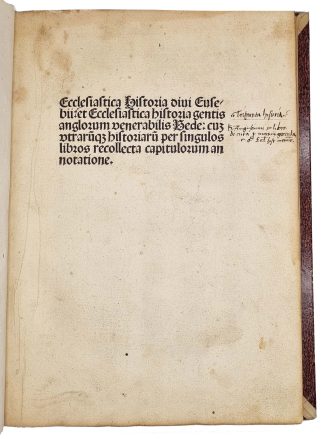EUSEBIUS, BEDA.
CONTEMPORARY ANNOTATIONS
Ecclesiastica historia divi Eusebii. Ecclesiastica historia gentis Anglorum venerabilis Bede.
Strasbourg, [Georg Husner, 14 Mar 1500].£6,950.00
Small folio, 260 x 188mm. 2 works in 1, separate titles, ff. [160]. Gothic letter, double column, 50 lines per page. First title and following a little finger-soiled at outer margins, very minor repair to edge of k5-l3, light narrow water stain to some upper or outer edges, also to lower margin of first gathering, small scattered mainly marginal worm holes to first and final gatherings. A good copy, on thick paper, in half vellum c.1900 over paper-covered wooden boards, contemporary ms bibliographical note to title, intermittent contemporary ms marginalia in red or black to text, in a Germanic hand.
The first combined edition of the two most important and influential works on the history of the early Christian Church, with contemporary ms annotations. A disciple of the scholar Pamphilius – hence the name ‘Eusebius Pamphilii’ – Eusebius (d.339AD), Bishop of Caesarea, was an early Christian historian, exegete, and polemicist. The 9 Books of ‘Ecclesiastica historia’, here in its sixth edition, were translated into Latin by the 4th-century monk Rufinus Aquileiensis, and completed by him with 2 more. This remained the standard text, and the version read by Bede. The work is an account of church history from the 1st to the 4th century, following the chronology of Roman emperors, from the time of Christ to Constantine, with a focus on Christian bishops, persecutions, heresies and martyrdom, and on the Christians’ relationship with the Jews and the heathen. Most importantly, Eusebius employed and quoted from ancient sources preserved at the Library in Caesarea, several of which we only know of today thanks to this work. Here in its second edition, ‘Historia ecclesiastica gentis anglorum’ is the first history of the early Christian church in England, written by the English monk Bede (672-735), as well as the first ever history of England. Bede drew greatly from Eusebius – e.g., the chronological arrangement, the interest in heresy and in the episcopal succession in Britain – adding ‘dramatic’ features such as direct speech or obituary notices (Thacker, p.172). After an introduction to the geography of Britannia and Hibernia, the work explores, in 5 chapters, English history from the time of Vespasian to Offa, King of Mercia. This is interspersed with annalistic sections on missions (e.g., Augustine), the conversion of the Britons, episodes in the reigns of the Saxon kings concerned with conversion, the strength of their faith, their fight against the heathen (e.g., King Earconbrech) and the foundation of monasteries. The contemporary annotator of this copy added ms marginal glosses to Eusebius’s ‘Historia’: in particular, to sections concerning magic or supernatural events (e.g., Simon Magus, the prodigies before the war under Vespasian), the cruelties of the siege of Jerusalem), the Antichrist, martyrdom and Origen. His note ‘et Tripartyta historia’ next to the general title is most probably a reference to another collection on ecclesiastical history with works by Greek authors, printed by Prüss in Strasbourg in the same year.
Goff E129; HC 6714*; C 2356 (incl. 932); BMC I 162; GW 9439; ISTC ie00129000. A. Thacker, ‘Bede and History’, in The Cambridge Companion to Bede, ed. S. Degregorio (2010), pp.170-189.In stock




